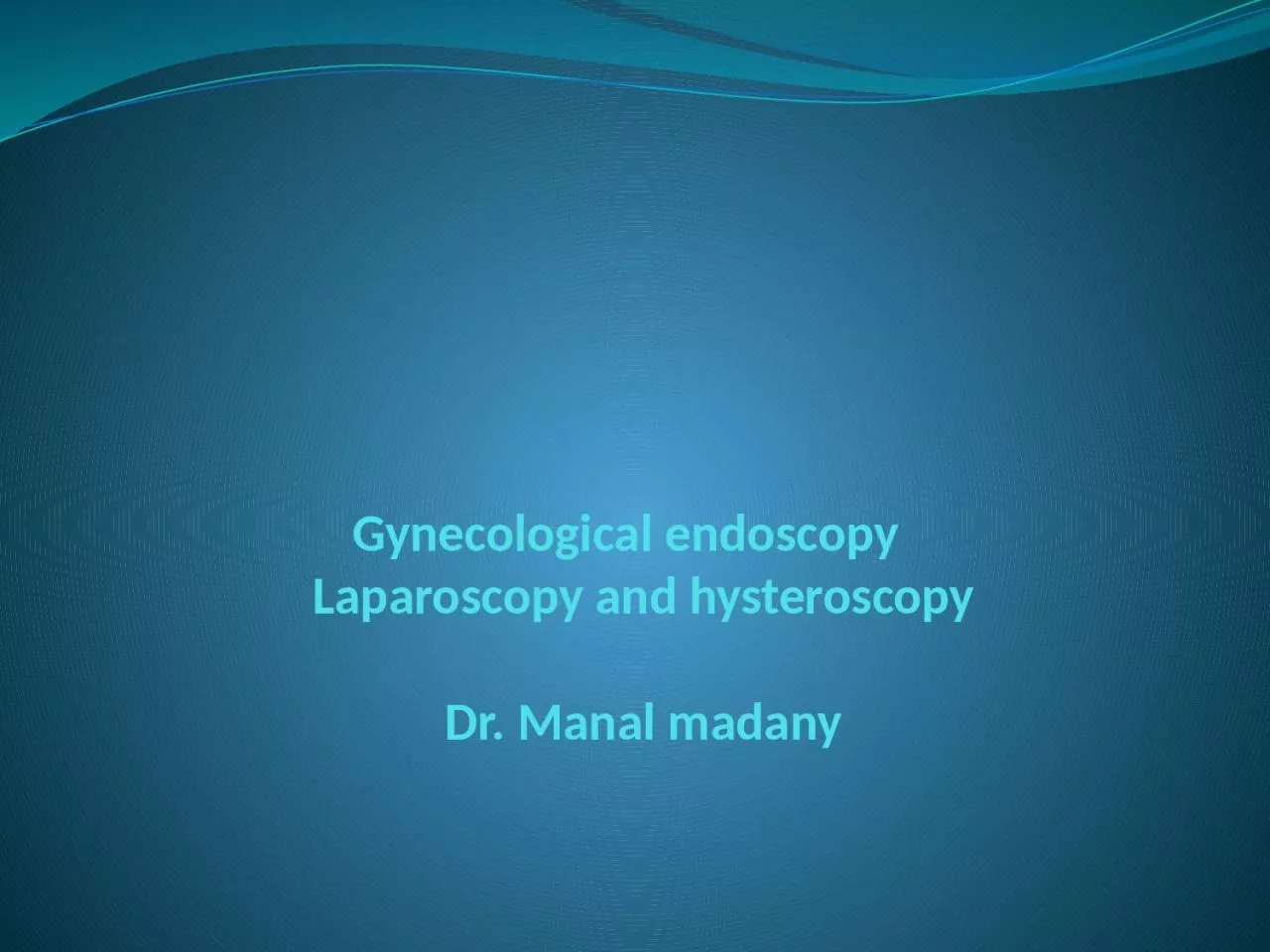

Laparoscopy and hysteroscopy Dr Manal madany Minimal Access Surgery MAS has affected every area of gynaecology from diagnosis to therapy The advantages of MAS over traditional open surgery seemed obvious ID: 928045
Download Presentation The PPT/PDF document "Gynecological endoscopy" is the property of its rightful owner. Permission is granted to download and print the materials on this web site for personal, non-commercial use only, and to display it on your personal computer provided you do not modify the materials and that you retain all copyright notices contained in the materials. By downloading content from our website, you accept the terms of this agreement.
Slide1
Gynecological endoscopy
Laparoscopy and
hysteroscopy
Dr.
Manal
madany
Slide2‘Minimal Access Surgery’ (MAS) has affected every area of
gynaecology
, from diagnosis to therapy. The advantages of MAS over traditional open surgery seemed obvious:
1 – less post-operative pain.
2- shorter hospitalization.
3- faster return to normal activities.
4- less adhesions formation
Slide3What is laparoscopy?
Slide4Laparoscopy
Laparoscopy
allows visualization of the peritoneal cavity. This involves insertion of a needle called a
Veress
needle into a suitable puncture point in the umbilicus. This allows
insufflation
of the peritoneal cavity with carbon dioxide so that a larger instrument such as
trocar
and
cannula
can be inserted
Slide5The majority of instruments used for diagnostic laparoscopy are 5 mm in diameter, and 10 mm instruments are used for operative laparoscopy. The procedure usually performed as an inpatient procedure under general anesthesia.
Slide6laparoscopy
Slide7Slide8Patient Preparation & Counseling
-Counseling about the procedure & expected outcome
-Bowel Preparation to facilitate the visualization of operative area & reduced chances of bowel injury
Slide9Limitation of Laparoscopy
Reduced exposure of operating field
Skilled person
Expensive Instruments
Cost is high
Prolonged operating time
Prolong
anaesthesia
Increased risk of complication in less skilled person
Slide10A safe entry technique for laparoscopy
:
The patient should be lying flat
Ensure the bladder is empty
check the abdomen for masses
Make the primary incision at the base of the umbilicus
Insert the
veress
needle through the base of the umbilicus, sensing a double click
Insert 2-3 ml of saline through the
veress
needle; it should run in freely
Aspirate back; nothing should be aspirated
Fill with co2 to 25mmhg
Insert the primary
trocar
Slide11Insertion site of
Insufflation
needle and primary
canula
Slide12Veress
needle
Slide13Trocar
and
cannula
Slide14Instruments
1.
Veress
needle:
Slide15Tests
for successful entry into peritoneal cavity is
1. Drop of saline gets sucked.
2. Nothing comes after aspiration with syringe
Slide16Camera
equipment
.
Light source
.
Slide17Specimen Removal Bag
Slide18Indications of laparoscopy
1
.Diagnostic indications
:
a.pelvic
pain (acute and chronic)
b.ectopic
pregnancy
c.pelvic
inflammatory disease
d.endometriosis
e.infertility
f.others
like pelvic mass and staging of ovarian malignancy
Slide19Healthy tube and ovary
Slide20Endometriosis
Slide212.
Therapeutic indications
: various surgical procedures can be performed by laparoscopy:
a.sterilization
b.aspiration
of an ovarian cyst, ovarian biopsy and drilling.
c.salpingectomy
and
salpingostomy
for ectopic pregnancy
d.treatment
of endometriosis with laser or
cautery
e.myomectomy
f.others
like laparoscopic assisted vaginal hysterectomy,
prolapse
and incontinence procedures
Slide22Electrosurgical
coaggulation
Slide23Clip application
Slide24salpingectomy
Slide25Salpingotomy
Slide26Ovarian drilling
Slide27Ovarian
cystectomy
Slide28Slide29Contraindications
:
Conditions that increase the risk of complications as
:
Mechanical or paralytic bowel
obstruction
generalized
peritonitis
Diaphragmatic hernia
Major
intraperitoneal
haemorrhage
severe
cardiorespiratory
disease
Massive obesity
inflammatory bowel
disease
large abdominal mass
multiple
abdominal incisions.
Slide30Complications of laparoscopy:
Diagnostic laparoscopy is a safe procedure with published complication rates of 2–4 per 1000, however the complications are more with operative laparoscopy
1. When the abdomen is being instrumented injury to the inferior
epigastric
vessels or
intraperitoneal
vessels and organs like bladder and bowel injury may occur (emptying the bladder prior to surgery can reduce bladder injury).
Slide312.
Anaesthetic
complications
3. Surgical emphysema due to leakage of co
2
into subcutaneous tissue
4. Infection
5. Venous
thromboembolism
and port site hernia
6.
Incisional
hernia has been reported
Slide32Hysteroscopy
Hysteroscopy involves passing a small-diameter telescope, either flexible or rigid, through the cervix to directly inspect the uterine cavity
.
Slide33Types of hysteroscopy:
1. A flexible
hysteroscope
may be used in the outpatient setting, with carbon dioxide as a filling medium.
2. Rigid instruments employ circulating fluids and therefore can be used to visualize the uterine cavity even if the woman is bleeding.
The procedure can be performed under local, regional or general
anaesthesia
.
Slide34Slide35Slide36Slide37Normal uterine cavity
Slide38Indications of hysteroscopy
1
.Diagnostic hysteroscopy
: with target biopsy
a.abnormal
menstruation,
intermenstrual
bleeding,
postcoital
and postmenopausal bleeding.
b.Abnormal
pelvic ultrasound findings (e.g. endometrial polyps,
submucous
fibroids)
c.
Subfertility
d. Recurrent miscarriage
e.
Asherman’s
syndrome
f. Congenital uterine anomaly
g. Lost intrauterine contraceptive device (IUCD)
Slide39Slide40Lost IUCD
Slide412
.Operative hysteroscopy
:
Hysteroscopic
surgery has a number of well-defined indications and is the treatment of choice for:
1.
polypectomy
.
2.
myomectomy
for
intracavitary
or
submucous
fibroids
3.
adhesiolysis
of intrauterine adhesions
4.
metroplasty
(division/resection of uterine septum).
5.endometrial ablation (destruction of the
endometrium
). 6. hysteroscopic
sterilization
Slide42Slide43Electrosurgical
coaggulation
Slide44polypectomy
Slide45sterilization
Slide46Submucous
Fibroid
Pedunculated
Myoma
Slide47Pre-Op
Laboratory Studies
Electrolytes if patient on diuretics or cardiac meds
Complete blood count
Coag
. Panel if history of bleeding tendencies
Document normal Pap smear and normal endometrial sample within 6 months
Slide48Postoperative
Patient
recovery
typically is rapid and without complication following dilatation and curettage
Diet and activities
may be resumed as desired by the patient
Spotting or light
bleeding
is not uncommon and typically stops within days
Slide49Contraindications of hysteroscopy
1. Pelvic infection
2.Pregnancy
3.Cervical cancer
4. Heavy uterine bleeding
Slide50Complications of hysteroscopy:
Diagnostic hysteroscopy is a safe procedure, and complications are uncommon. However operative hysteroscopy carries a higher risk of complications:
1.
Anaesthetic
complications
2. Uterine perforation
3. Fluid overload so careful monitoring of fluid input and output is required
4.
Haemorrhage
5. Gas embolism
6. Infection
7. Cervical trauma
Slide51THANK
YOU